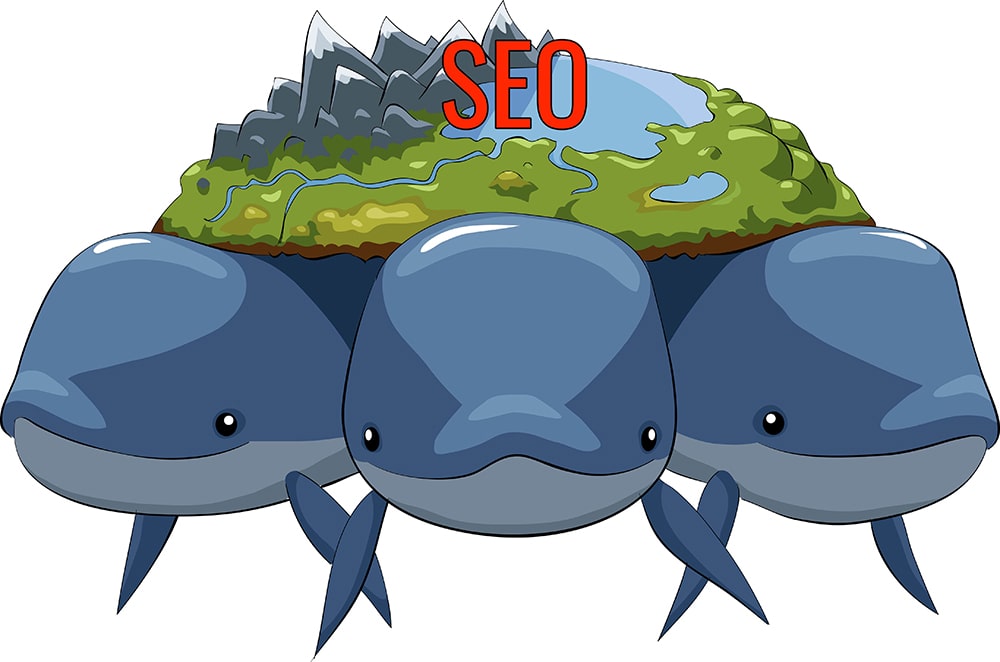Many novice website owners and SEO optimizers tend to make the same mistakes, investing their budget into tools that either have little to no impact on successful search engine promotion or contribute in the smallest possible way.
This is understandable—lack of experience and blind trust in numerous scammers and extortionists posing as SEO specialists prevent them from making informed decisions. Even if they manage to create a somewhat decent website without financial investment, their next steps often lead them in the wrong direction.
The Three Pillars: Links, Unique Content, and …
The two biggest expenses for a beginner SEO optimizer are unique content and link building. These two aspects require financial investment—often significant—but ironically, they are the very ones that should be excluded from the initial promotion strategy. The money saved could instead be spent on a much more effective approach. But let’s take things step by step.
According to many so-called «professionals» and «gurus,» the key stages of website promotion to the top of search engine rankings consist of purchasing a large number of unique articles and backlinks. These can be acquired on specialized marketplaces—both content and link-building platforms. Naturally, the quality of content and backlinks varies widely, and so do their prices—high-quality ones are expensive, while low-quality ones are cheap. The more rational and financially secure beginners, of course, try to buy the best they can afford.
Those with a smaller budget have to settle for lower-quality options. Before «launching a website,» meaning starting its promotion, it must be populated with content. Search engines claim that only websites with unique content have a chance at success. Of course, other content qualities also matter—such as being error-free, engaging for readers, and properly formatted—but uniqueness remains the top priority.
Search engines are unable to directly assess the behavioral qualities of texts. Instead, they rely on user interactions—how long visitors stay on the site and the sequence of their actions—to determine content quality.
Behavioral Factors in Promotion
If visitors enjoy the content, the website’s behavioral factors are positive. If they don’t, they are negative. And this is where content uniqueness does not play a decisive role at all.
The truth is, there is almost no truly unique content on the Internet. Or rather, it exists—but only briefly. As soon as new texts appear on a website, they are quickly copied by other sites. In fact, unique content is sometimes stolen automatically using specialized software.
Internet users don’t pay attention to this at all because they typically start “clicking through” websites from the top search results. And at the top, you’ll usually find authoritative websites with strong search engine rankings. Many of these sites steal unique content from younger websites that struggle to reach the top, meaning visitors constantly see fresh, unique articles without ever realizing they are reading a copy rather than the original source.
Even if a search engine detects duplicate content, as long as visitors enjoy the copied content on high-ranking sites, the search engine doesn’t take any punitive actions against them. The only real concern is the legal aspect of such content borrowing. However, reputable websites don’t usually steal content outright. Instead, they selectively take articles from sources that don’t mind their content being reused, often with a backlink to the original source.
Moreover, these high-ranking sites only borrow genuinely interesting and useful articles for their audience, which naturally results in excellent behavioral factors that help maintain their top positions.
Is Unique Content a Panacea?
As we can see, trying to promote a new website solely through unique content is a failing strategy that leads nowhere. So why waste money on purchasing such articles? It’s completely pointless—unless, of course, you want to selflessly help top-ranking websites strengthen their positions even further at your own expense.
The smarter approach is to start with curated content that is interesting and valuable to visitors. However, outright stealing content is not advisable. Providing a backlink to the original source won’t harm your website, but it will allow you to quickly grow by filling your site with engaging, even if not entirely unique, content. This approach gives your website a solid initial boost in the eyes of search engines.
What About Backlinks?
The next major expense for beginner SEO optimizers is acquiring backlinks. There has long been a belief that no website can achieve high search rankings without links from other sites. While it’s not accurate to say that backlinks harm a site, it’s also possible to successfully promote a website quickly and reliably without a large number of them. In fact, backlinks play little to no role—except for those that are out of reach for most webmasters trying to push their sites to the top of search engine rankings.
There was a time when even a large number of low-quality backlinks (from “half-dead” web resources) could significantly boost a website’s ranking. Spammers and doorway page creators took full advantage of this, and for a long time, search engines struggled to find an effective way to counteract them. Eventually, search engines decided to remove from their ranking system all backlinks that didn’t fulfill their primary purpose—actual user clicks.
For several years now, it has been impossible to promote a website using “dead” links, and even “half-dead” links are largely ineffective. The only valuable backlinks today are “live” ones—links from well-optimized websites with substantial traffic, ensuring that these backlinks remain active and relevant.
The decision by search engines also hit various «link marketplaces» hard. These platforms used to make huge profits from selling backlinks, and search engines had long struggled to fight them effectively. In reality, truly «live» backlinks are rarely sold on such marketplaces, and if they are available for purchase, they come at a hefty price. This makes them unaffordable for beginner SEO optimizers and SEO scammers alike.
There is, of course, a way to obtain backlinks for free from high-authority forums, blogs, social networks, and similar web resources. However, doing so requires significant effort, which many are unwilling to put in.
That said, link marketplaces have not suffered as much as one might think. This is mainly due to their aggressive marketing campaigns, which promote the idea of buying backlinks as a must-have SEO strategy. And this is something search engines simply cannot fight against. As a result, beginners and less experienced webmasters continue purchasing backlinks in bulk. If they believe these backlinks are helping their websites rank higher, it’s usually not because of the «dead» or «half-dead» links themselves.
Instead, other factors come into play—one of which was briefly mentioned earlier: continuous work on the website. Regular updates, expansion, and an increase in the number of pages are what search engines pay the most attention to.
However, once such websites start reaching the top rankings and attracting traffic, behavioral factors come into play. If the website is well-made and engaging, it will begin to grow even faster. But if it’s not, the webmaster will never blame the purchased backlinks. Instead, they will look for another reason—and, more often than not, they won’t find one.
They will continue buying more and more unique content (which greatly benefits content marketplaces), more backlinks (which greatly benefits link marketplaces), and when their budget is finally exhausted, they will give up on website building—much to the delight of their competitors.
How to Properly Promote a Website?
So how can a beginner promote a website effectively if they have some budget for its growth? Many experienced SEO specialists, when looking to promote their websites, start by purchasing traffic for their new site.
As mentioned earlier, search engines closely monitor user behavior on websites and have advanced tools for doing so. If a website is high-quality and visitors enjoy it, search engines will start rewarding it with bonus after bonus, gradually pushing its pages to the top rankings for various search queries.
But if a website is new and hasn’t even come close to top rankings yet, how can it possibly have any traffic? If there is a real desire to invest money into promotion, it should be spent not on content or backlinks, but on traffic itself. Naturally, the website must be engaging for the incoming traffic—otherwise, the effort will be wasted. Poor behavioral factors will result in no real benefits from the traffic boost.
How to Attract Visitors to a Website?
What kind of traffic is best to buy, and where should you get it? The most effective option is to purchase traffic directly from Yandex and Google. While it’s not cheap, it is highly targeted, meaning high-quality, and if the website is good, all the expenses will pay off handsomely.
Other options include buying traffic from reputable, verified traders. Their traffic is usually more affordable (depending on volume), although it may not be as precisely targeted. Additionally, it can be worthwhile to purchase traffic from affiliate programs like «Teasernet.» However, it’s crucial to be cautious and avoid scammers who might sell low-quality junk traffic—or worse, flood your site with bots.
If you’re willing to put in the effort, you can try generating traffic from forums, social networks, and directories. This approach not only allows you to gain traffic for free but also helps you acquire valuable direct, “live” backlinks to your site, which further aids in website promotion.
However, while this method is highly promising, it’s also challenging and requires serious psychological and intellectual effort—especially when it comes to forums. You need to do more than just outsmart moderators by convincing them that you’re not a spammer and that your links aren’t mere advertisements. You also have to engage forum users so they genuinely want to click your links, thereby keeping them “alive” for search engines while also taking the actions on your site that you need them to.
The same principle applies to blogs and social media platforms. Another option is to build and promote your own social media accounts and use them as a base for placing links. This way, moderation issues disappear, but the challenge of generating user interest remains.
You can also submit your site to well-established directories that feature ranking systems. However, to secure a top position in these rankings, you need to drive traffic to them—not directly, but from your own website. This means directing visitors who have already engaged with your site to these directories.
A ranking system is essentially a top-list, and by sending a certain number of visitors to it, you help boost your site’s ranking (similar to how search engines work). In return, you receive many more visitors from these directories than you originally sent. Many professionals leverage this strategy, and if a beginner wants to become a pro, mastering this technique is a must.
So, based on everything you’ve read, you can see that beginners make a big mistake by wasting their money, effort, and time on purchasing unique content and backlinks from marketplaces. Instead, the focus should be on buying traffic. If the traffic is high-quality and directed to a well-optimized website, its pages will quickly climb the search engine rankings, providing an excellent opportunity for a beginner SEO specialist to become a professional and recover all their investment in promoting their first project.
After reading this article, you might think that all you need to do is create a website, copy some articles from other sources, and that’s it—PROFIT, as they say? I wouldn’t recommend taking such an approach. There are many other factors that can play both a positive and a negative role in your site’s promotion.
Every project should be considered individually, and an SEO strategy should be tailored specifically for each site. And for that, you need an experienced SEO specialist—just like us! 🙂
Feel free to reach out to our web studio—we provide SEO services worldwide!



